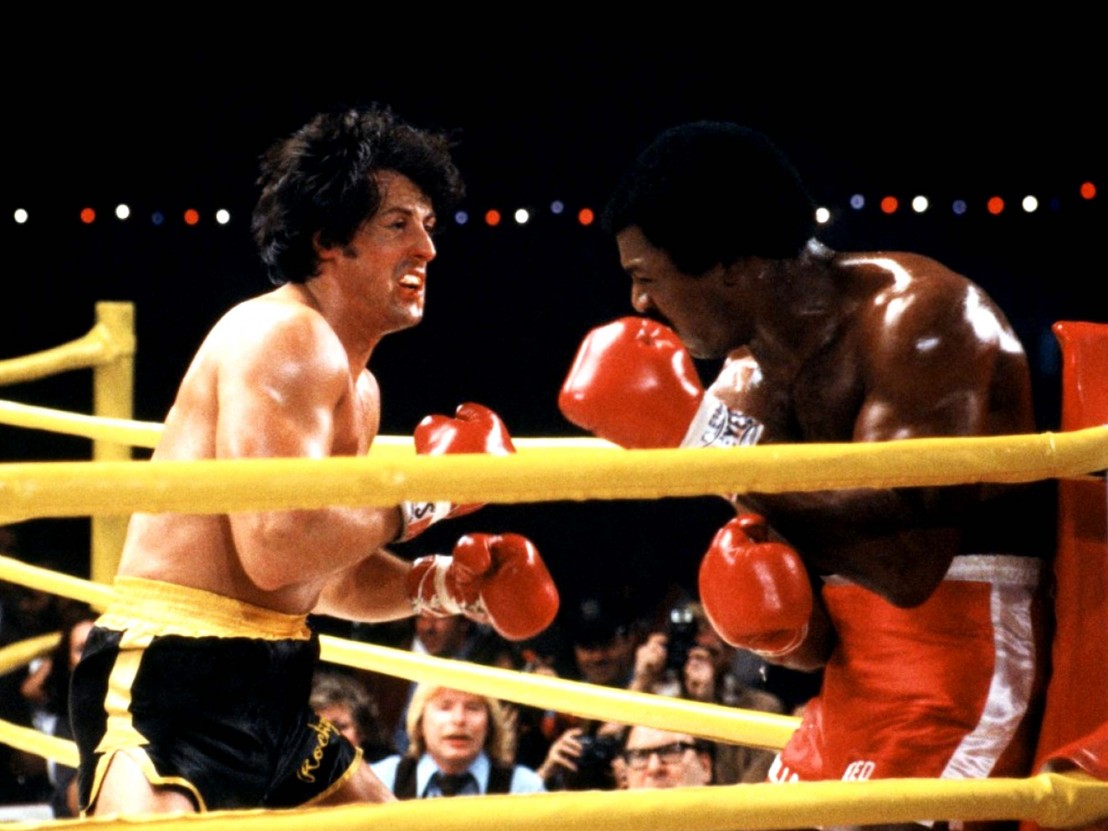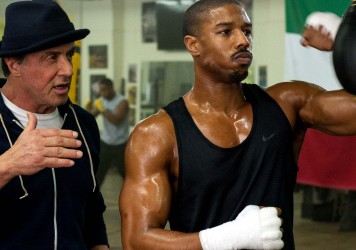
Last November, the New York Times ran a think piece calling for the abolition of boxing, referring to it as a ‘brutal, fading sport.’ But if the mystique of prize-fighting has dissipated in recent years, the latest trickle of Hollywood releases on the subject haven’t acknowledged it. In fact, last year’s trickle looks to be this year’s wave, with biopics of fighters Emile Griffith and Roberto Duran set for release in 2016.
The topic gets an invigorating treatment in Ryan Coogler’s Creed, the seventh instalment in the evergreen Rocky series. The director’s debut film, Fruitvale Station, clearly foregrounded concerns around race and social division. Although Creed resists a similar label, Coogler’s socially conscious background offers a surprisingly strong foundation for the boxing genre – a cinematic sporting tradition that has consistently been the domain of America’s minority working-class.
As early as 1910, boxing has played an important role in both race relations and film history. When first-ever black heavyweight champ Jack Johnson KO’d ‘great white hope’ Jim Jeffries in the so-called ‘Fight of the Century’ – exposing the lie of white superiority – race riots broke out across the nation. The immediate response in several states was an outright ban on prizefight films; one of the earliest instances of American film censorship. Such was the power of the fledgling medium. Motion pictures were perfectly suited to capture the sport’s dynamic movement – and its potentially revolutionary impact.
Prizefighting had its on-screen heyday in the ’30s and ’40s. Among the many catalysts for the ‘progressive’ boxing film were the respective surges in popularity of pugilism and moviegoing during the first half of the 20th century. Traditionally, fighters came from urban immigrant backgrounds, making them perfect salt of the earth heroes for Warner Brothers’ Depression-era output. This aligned with other progressive influences in Tinseltown at the time – the incipient rise of the Communist Party and left-wing activism came to have a significant relationship with the prizefight film. Familiar rags-to-riches plots became cautionary tales about the pitfalls of capitalism; heroic sports figures became dopes and heels, exploited by gangsters and corrupt managers. Throughout the ’40s, boxing films swelled the film noir ranks, offering an even more pessimistic interpretation of what had come before.
When it came to promoting white heroes, Hollywood had catapulted champs like Jack Dempsey and Max Baer onto the big screen in walk-on roles. But by 1937 the legendary Joe Louis was heavyweight champ, opening the door for African-American fighters that would soon dominate the sport over ethnic Jews, Irish, and Italians. Yet in the unrivalled 11 years that Louis was champ, not a single boxing film produced by a major studio featured a prominent black protagonist.
In terms of both race and class, a look at the output of two Hollywood screenwriters during this portion of the studio era – both active CPUSA members and later victims of the McCarthy blacklist – proves illuminating. Carl Foreman is perhaps best known for penning High Noon, but did equally subversive work with his 1949 Kirk Douglas vehicle, Champion. Douglas stars as a champ with dubious morals; his all-American success story is implicated as a racket where only the ruthless truly succeed.
Screenwriter Abraham Polonsky made an even greater impact on the genre, first with 1947’s evocative and fiercely felt Body and Soul, starring John Garfield as fictional Jewish fighter Charley Davis. Davis is a man torn between the wealth of the big-time fight game and solidarity with his old world Brooklyn community. In the climactic final fight, Charley plans to take a fall for the short-term money, even though his neighbourhood has rallied around him and is gambling on his win.
Canada Lee co-stars as Ben, an African-American fighter forced to retire and work in Charley’s corner after the ring doctor warns that he has a potentially fatal blood clot on the brain. His friendship with Garfield’s Charley is a rare occurrence in Hollywood cinema of the 1940’s; the narrative hinges on the brotherhood and solidarity between a black and a Jewish fighter. Once again, race in boxing had managed to raise the ire of American film censors – the Production Code Administration moved to have Lee’s character completely excised from the script.
They managed only to remove one sequence, in which black and white boxers fight, citing the PCA’s refusal to show ‘intermingling’ of the races. In spite of Jack Johnson and Joe Louis’ achievements, Body and Soul was forced to relegate Ben to a supporting role – and yet his sympathetic on-screen appearance amounted to something more prescient. Polonsky later spoke about the production team’s refusal to remove Ben from their script: “There is an obvious deep relationship between people held not so much in contempt but in antipathy by society.”
“If Rocky answered late ’70s disillusionment with a champion the white working-class could call ‘their own’, then Creed flips the script completely.”
Later films, such as 1962’s Requiem for a Heavyweight, deal less in allegory, expressing more literal ambivalence about boxing’s opposing qualities. There is potential glory for the working-class man on one hand, untold treachery on the other. Ralph Nelson directs a faultless cast, featuring Anthony Quinn as a big, sweet lout who has reached the end of his professional career as a heavyweight journeyman. He’s punch-drunk and lonely, with few future prospects.
His promoter, played by Jackie Gleason, is being pressured by the mob to keep earning. Quinn’s fighter seems loosely based on Primo Carnera – a freakishly tall fighter who briefly held the heavyweight title. He was wheeled out as an attraction (‘the man mountain’) and later put out to pasture on a humiliating wrestling circuit. It’s a fate that Quinn shares onscreen, making Requiem tragic enough to border on the maudlin. But Nelson and writer Rod Serling make their case vehemently. The ring and its mobbed-up promoters will always need hapless, uneducated fighters as grist for their mill. Nonetheless, the ring gives something back to these men, too.
One thing that most studio-era filmmakers seem to agree on is the crookedness and brutality of the endeavour itself. Given the fate of so many real-life fighters, it’s hardly surprising that relatively few boxing films trade in happy endings. And yet socially conscious filmmakers continue to return to the boxing genre, offering glory and upward mobility as a genuinely attractive avenue for working-class men. This presents a conundrum; boxing might be the ultimate symbol for the exploitation of the proletariat – both physically and financially – but in the limited realms of the existing system, the sport is also be a powerful symbol of achievement and discipline.
This idea is exemplified in Robert Wise’s 1956 film, Somebody Up There Likes Me, a celebrity-endorsed biopic of Rocky Graziano. It’s this that the Rocky franchise passingly resembles; beyond the shared name, both Graziano and Balboa are lovable Italian roughnecks fighting against the odds. Both have a degree of optimism that Creed doubles down on.
Some critics back in 1976 felt that Rocky’s optimism came at Apollo Creed’s expense. A few even saw the blue-collar Rocky as a symbol of ‘white working-class resentment’ of black advancement, at a time when African-Americans had long ruled the heavyweight division. If Rocky answered late ’70s disillusionment with a champion the white working-class could call ‘their own’, then Creed flips the script completely. Adonis Creed (Michael B Jordan) is the inverse of his old pug trainer – a fabulously wealthy African-American, for whom, perversely enough in traditional genre terms, neither class nor race are a point of contention.
Though Adonis spends much of his childhood in a care home and seems to eschew the trappings of his inherited wealth when he moves to Philly, the fact remains that he’s far from the stereotype of the downtrodden fighter. If anything, Adonis’ wealth is painted as an obstacle. Coogler isn’t making a picture of socially conscious intent here. He’s expanding on the spirit of the Rocky movies – triumph in the face of adversity. There’s an understanding shared by Body and Soul’s ambiguous conclusion; you can lose the battle but win the war, whether that war be waged in the name of working-class solidarity, racial equality, or something less lofty.
In Creed, those battles are with old age, or the shadow of a titanically famous father. In fact, it’s the film’s implicit awareness of the relative comfort of its characters that gives new mileage to the story. There are no crooked managers or shadowy mobsters – just Stallone giving a poignant, modest performance as Creed’s trainer. Stallone and Jordan’s cross-generational relationship is portrayed with ease and grace. It’s almost Creed’s lack of acknowledgement of how it fittingly passes the baton that makes it feel so progressive.
From the music to the iconic ‘Rocky steps’, Creed is a film that embraces its heritage. Perhaps this is fitting, given that the boxing genre has always been susceptible to cliché. But as with other genre fare – the western, for example – the best boxing films use their familiar archetypes and stock characters as a tool for social change. It’s why boxing films, like westerns, can be mythic and gladiatorial, and how they are able to respond to and criticise American cultural values. On masculinity, race, class, and violence – they’ve long had something of value to add to the cultural conversation.
Tweaking the formula without completely reinventing it while avoiding any overt political message, Coogler offers Creed as a feel-good fight yarn with credibility and bite. But its quietly revolutionary inversion of old tropes also make it a worthy inheritor of the boxing genre’s great tradition.
Published 11 Jan 2016

By Ashley Clark
A franchise is reborn in sensational fashion courtesy of director Ryan Coogler and star Michael B Jordan.

Watch the latest episode of our weekly review show, featuring Justin Simien’s witty college comedy.

This uncomfortable and predictable melodrama concerns a plucky ex-con desperately attempting to go straight.